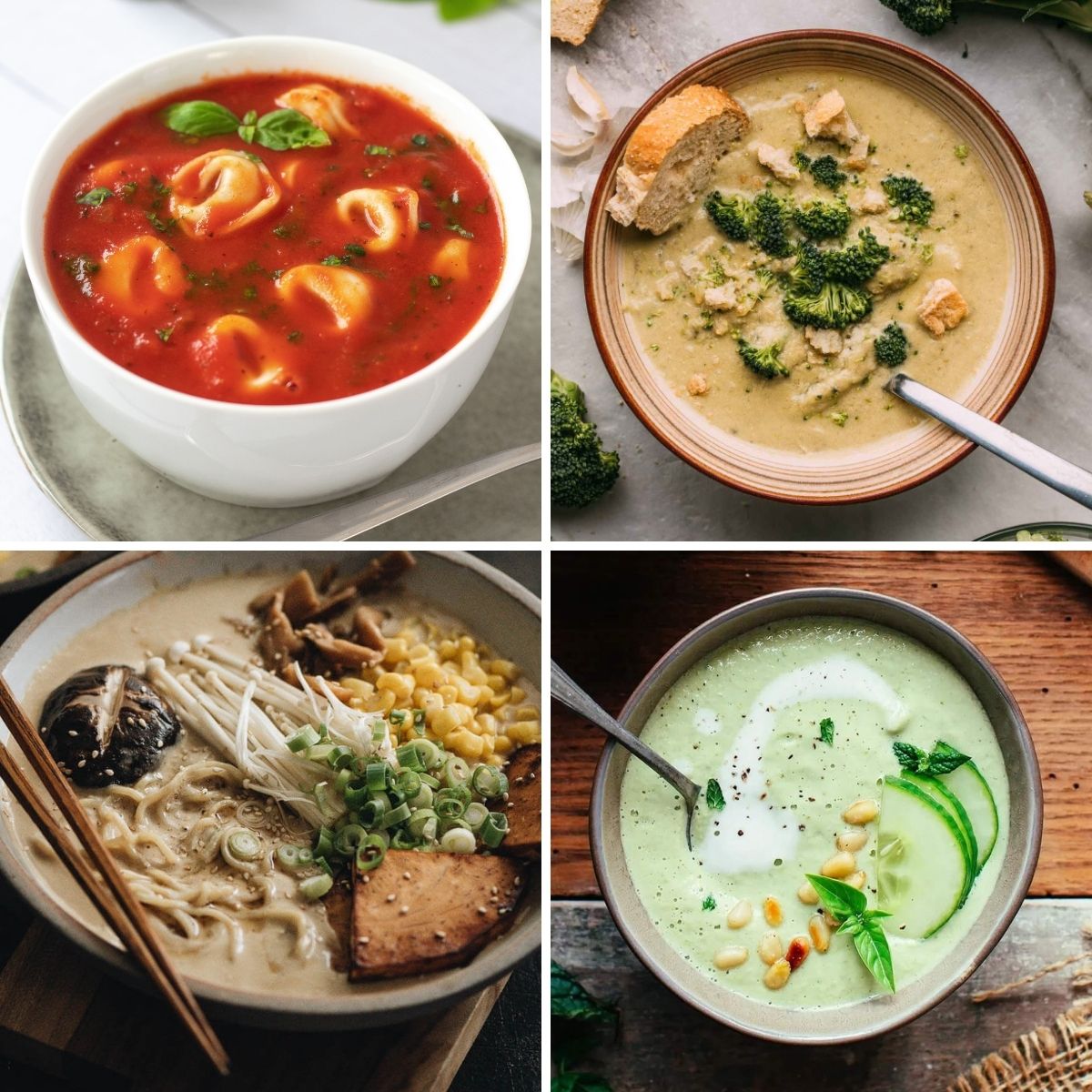High Protein Vegetarian Meal Plan
HurryTheFoodUp is reader-powered. If you click through using links on our site we may earn a small commission at no cost to you.
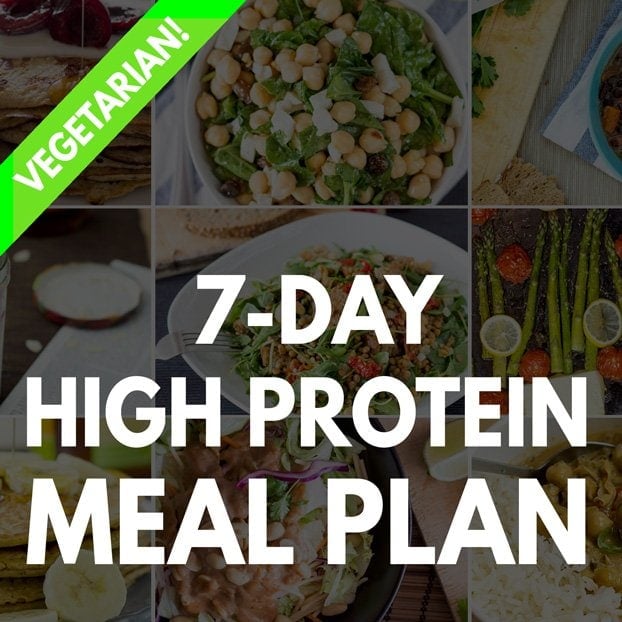
Ready to take your progress to the next level? Welcome to the only high-protein vegetarian meal plan you’ll ever need.
Let’s be honest, vegetarians have a harder time following a high protein diet than people who eat meat. I’m here to change that.
If you’re trying to build muscle on a vegetarian diet, I’m sure you’ve asked yourself “how can I get enough protein?”. Muscle mass doesn’t happen on its own.
Equally, if you’re trying to lose weight and tone up with a high-protein diet, I bet you’ve asked yourself the same question.
How to download our free high protein vegetarian meal plan
Ready to get started? Simply sign up in the box at the top of this page, or visit this page to get your free copy of the high protein meal plan.
From there we’ll send you an email with our high protein vegetarian diet plan pdf, so keep an eye on your inbox and get ready to enjoy a week of tasty meals!
Muscle Mass vs Weight Loss
Building muscle mass or losing weight and getting that really ‘toned’ look are two separate goals. Each requires a different amount of calories. However, both require higher amounts of protein.
I’ve taken into account the difference in calorie requirements and made three versions of our high protein meal plans.
When you download the PDF you’ll see the three different plans.
Naturally, they are suitable for both females and males, or indeed, any gender.
We focus on delicious high protein vegetarian meals
A great breakfast followed by an easily packable lunch and a solid dinner is the easiest way to a well-balanced protein intake and the building blocks of a healthy life.
The recipes were developed by us specifically for this high protein meal plan, and each recipe is a tried and tested favourite, guaranteed to work every time.
We’ve created these meal plans in a way that most of the general population can use them. But of course, you should be following your own needs.
Day 1 of the meal plan

Here’s the first day of the high protein meal plan. We kick things off with:
Main Meals:
Breakfast: Banana Egg Pancakes (504 kcal, 28g protein)
Lunch: Bulgur Kidney Bean Salad (649kcal, 23g protein)
Dinner: Easy Broccoli Stir Fry (634 kcal, 29g protein)
Small Snacks:
Protein Shake (120kcal, 23g protein)
Nuts and Fruits of Choice (306kcal, 7g protein)
Big Snack:
Standard Muesli (521 kcal, 22 g protein)
Daily Total:
Main Meals: 1787kcal, 80g protein
Small Snacks: 426kcal, 30g protein
Big Snack: 521 kcal, 22 g protein
So, depending on your calorie needs you can easily adjust the meal plan with the snacks.
- Only need around 1800kcal? Stick with the main meals and some light snacks
- Need roughly 2200kcal? Go for the main meals and two small snacks (1800 + 400 = 2200kcal)
- Is 2700kcal about right for you? Have the main meals and all snacks (1800 + 400 + 500 = 2700kcal)
Easy!
How much protein is in the meal plans?
We always make sure you’ll get a minimum of 75g, 95g and 115g, depending if you skip or munch the suggested snacks. They also take fat and saturated fat into account to ensure you are getting healthy meal plans, which we haven’t found anywhere else.
You might think that the protein share in our meal plan is still not high enough. After all, it doesn’t reach the 1g protein/lb rule often promoted in the bodybuilding world – although that’s a contested issue, as you’ll see further on down.
We are an evidence-based site and use the latest research when considering how much protein should be in the plans.
So let’s do two things first: see what high-protein options you have and read up on how much protein you really need.
Let’s go.
So which high protein vegetarian foods are best?
Let’s dive into the various veggie protein sources and see what they can do for us. Below is a list of high-protein vegetarian foods that should be on your radar.
Dairy Products
If you eat a bowl of yogurt with oats as a snack and some cheese in a sandwich or in a salad then you’re already having a decent amount of dairy.
The jury is still out on dairy in terms of overall health benefits. It’s a source of saturated fat and the current guidance is that we should reduce our amount of saturated fat consumption – it should not make up more than 10% of the calories in our diet.
There is evidence that reducing saturated fat lowers the risk of heart disease and so until new evidence suggests otherwise we should aim to reduce it.
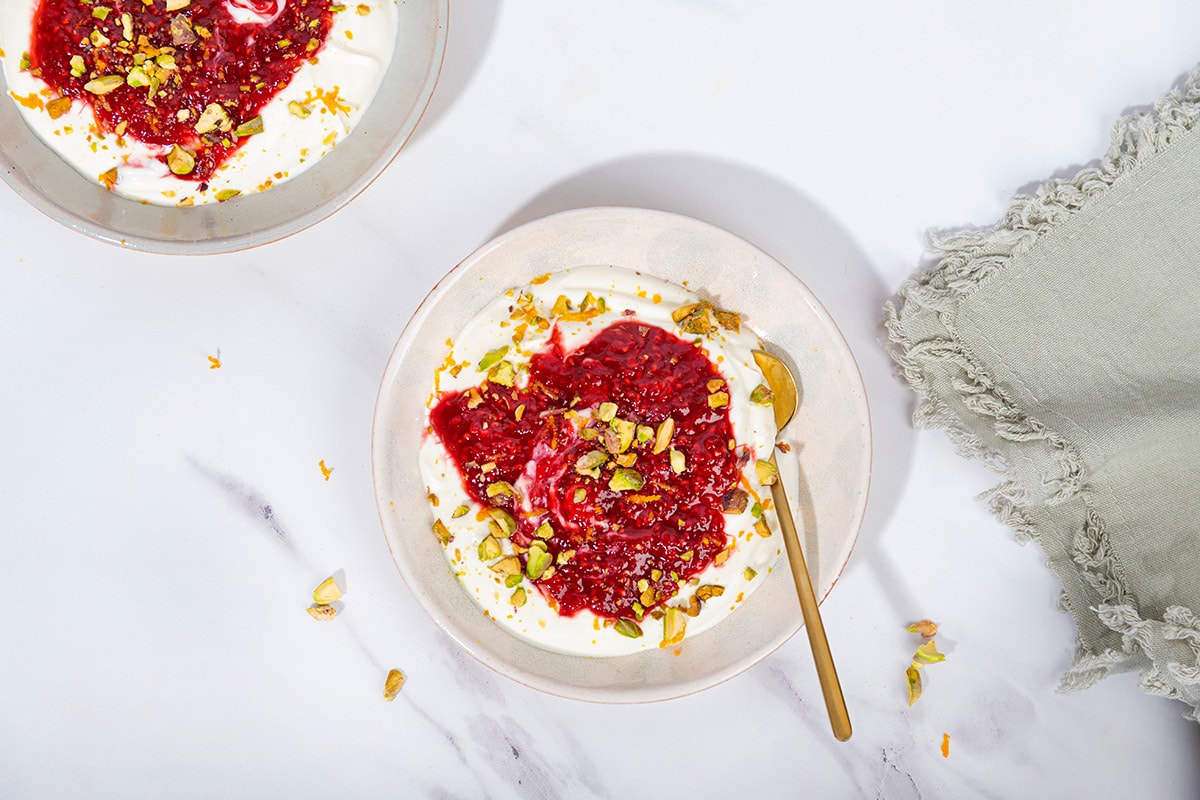
Legumes
I generally build a cup of legumes into my day.
I find that enough really and here’s why: the more beans, peas, chickpeas or lentils you eat the more of a fart festival you’ll be.
Get used to a small amount a day and work your way up from there.
Second, even though legumes are considered to be super healthy in mainstream medicine, there is some controversy about the dangers of their high phytic acid content.
Phytic acid makes it more difficult for your body to absorb nutrients like iron, zinc and calcium.
BUT: if you cook legumes properly you reduce the phytic acid amount to a safe degree. Same goes for canned legumes.
Still, like with everything – better not to overdo it, moderation is just fine.
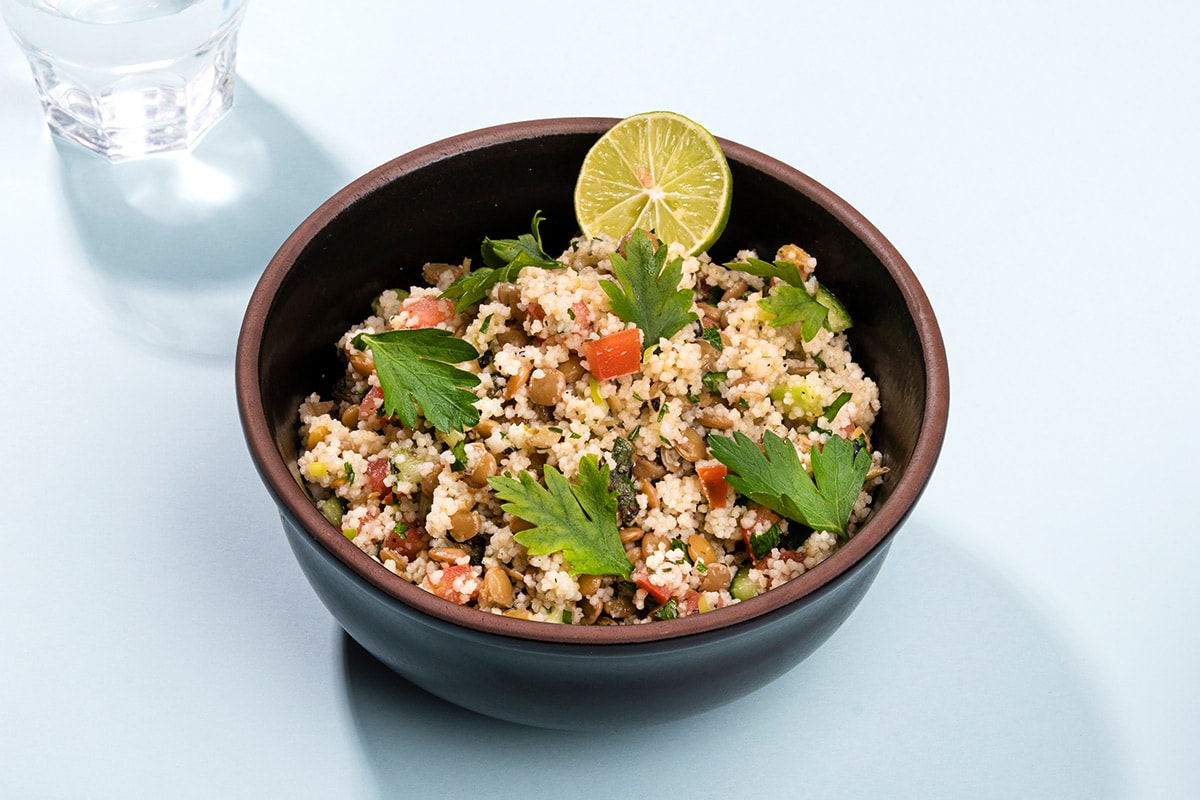
This simple lentil tabbouleh is one of my favourite recipes from the meal plan. Let me share it right away!
- 1 ½ cup brown lentils, cooked (roughly one 15oz can)
- 2 cup vegetable broth (divided)
- ¾ cup instant couscous
- 2 tbsp olive oil
- 1 green onion (finely chopped)
- 1 clove garlic (minced)
- 2 sprigs mint, fresh (chopped)
- 3 sprigs parsley, fresh (chopped)
- 1 tbsp water
- 1 tbsp lemon juice (or 1 tsp white vinegar
- 1 small tomato (diced)
- ½ medium cucumber (diced)
- salt and pepper to taste
- (Skip this step when using canned lentils). In a small pot add the lentils and 1 ½ cup vegetable broth. Once the liquid boils, cover, lower the heat and cook until the lentils are soft.
1 ½ cup brown lentils, cooked, 2 cup vegetable broth
- Meanwhile, add the couscous into a bowl. Pour in roughly ½ cup of hot vegetable broth until the couscous is just covered. Let sit for 10 minutes.
¾ cup instant couscous
- In a small bowl add onion, garlic, mint, parsley, water, lemon juice, salt and olive oil. Mix and rest until needed.
1 green onion, 1 clove garlic, 2 sprigs mint, fresh, 3 sprigs parsley, fresh, 1 tbsp water, 1 tbsp lemon juice, 2 tbsp olive oil
- Dice the cucumber and tomato and add to the couscous.
1 small tomato, ½ medium cucumber
- Once cooked, mix in the lentils and dressing. Season with salt and pepper. Add more lemon to taste. Done. Nice!
salt and pepper to taste
Nutrition Facts
High Protein Vegetarian Meal Plan – Build Muscle and Tone Up!
Amount per Serving
% Daily Value*
* Percent Daily Values are based on a 2000 calorie diet.
Soy Products
Soy belongs to the family of legumes. And it is undoubtedly a great source of protein. And plant-based protein at that.
But it deserves a separate paragraph as it’s used in so many meat replacement products. There has been concern over the years that soy might be bad for us – but an evaluation of the literature on soy suggests it is beneficial for us for lots of reasons.
It can help lower our cholesterol, risk of heart disease and of certain cancers.
As always, moderation is key. But there doesn’t seem to be any issue with soy being part of a balanced, healthy diet.
Grains (Bread, Pasta, Rice, Oats, etc.)
Grains are a great way to accompany almost any dish. Be it oats in your yogurt, pasta on the side or a slice of bread for your soup. Plus they contain a decent amount of protein.
Of course, ramping up on grains also increases your calorie count a lot due to their high carb content.
That again can lead to fat pads above your muscles 😉 . So be mindful of how much of them you eat – but don’t be scared of them, either!
When it comes to bread, pasta and rice, I always recommend whole grains over the more refined white sources. You’ll get a higher amount of protein, and more nutrients, too.
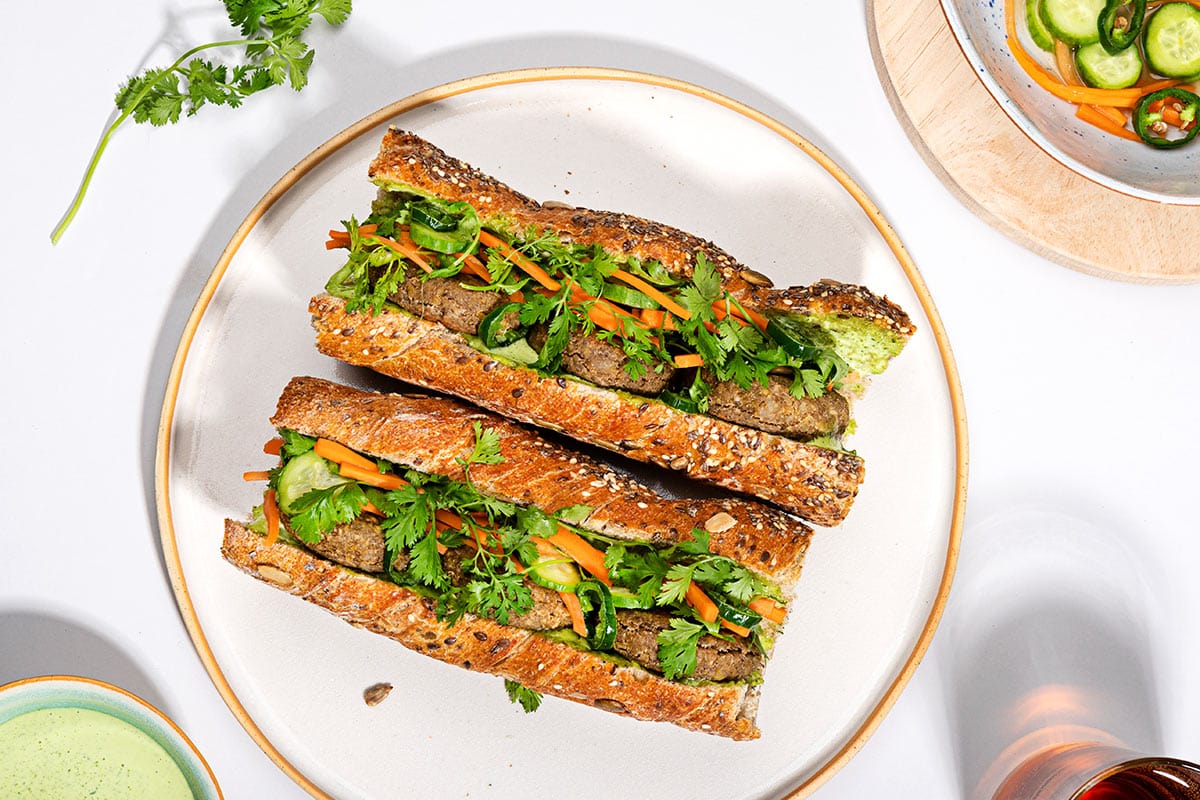
Nuts & Seeds
It’s great to have them in your diet, not only for protein but as they are often rich in other nutrients like iron and omega 3. But nuts also seem to be linked with a reduced overall risk of mortality – making them an awesome snack!
By increasing your protein intake through nuts, you’ll move up your overall calorie intake a lot as they are incredibly nutrient dense – so although they’re super tasty, maybe just keep them to a handful!
All sorts of nuts and seeds qualify here. Think chia seeds, hemp seeds, sunflower seeds. Peanuts, cashews and almonds.
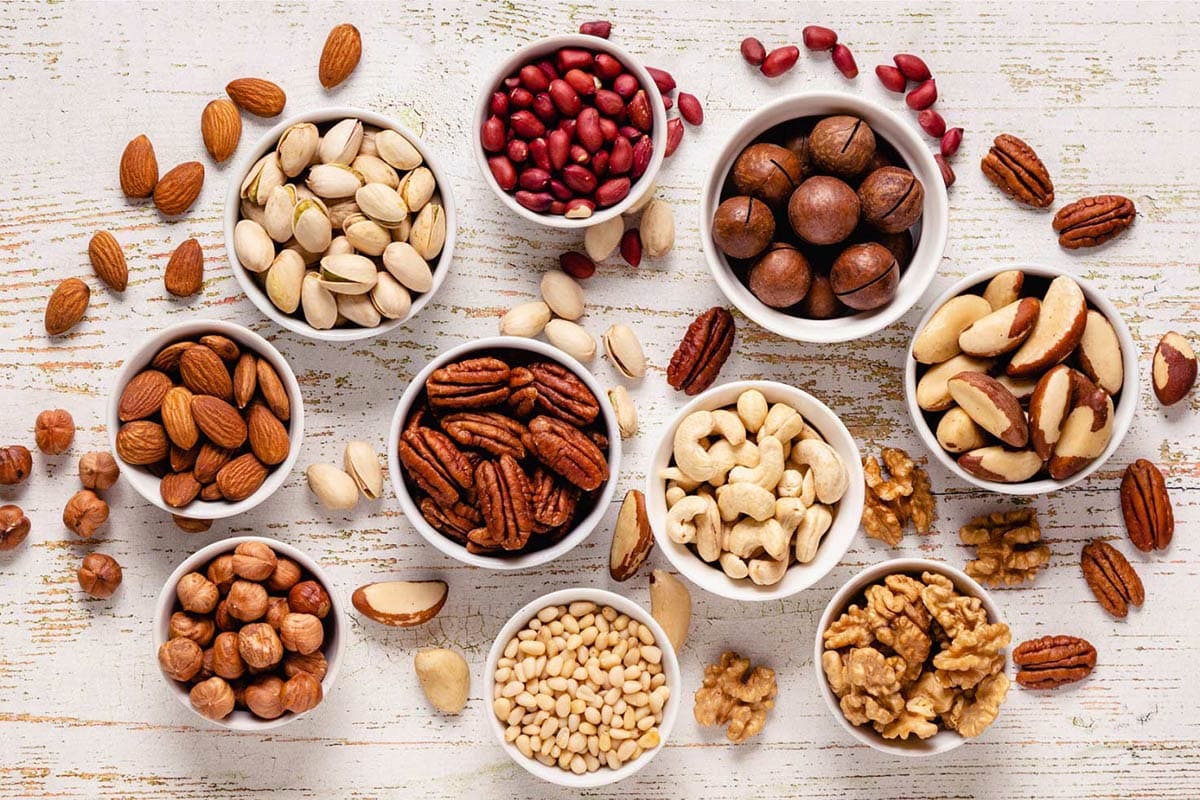
Eggs
Eggs are an excellent tool for vegetarians to build muscle. They have a good amount of protein in them, and they’re incredibly versatile.
They’re another one of those foods which got a bit of a bad reputation over the years but current evidence doesn’t seem to support that view.
A recent large scale review suggested that although there may be some negatives to consuming eggs, the positives seem to outweigh them.
When looking at it as a whole, our opinion is that eggs do fit in a diet as part of a healthy lifestyle. That is, in someone who generally has a good diet and exercises regularly.
I personally stick to 2-3 eggs a day at most and source my eggs carefully from an animal rights perspective.
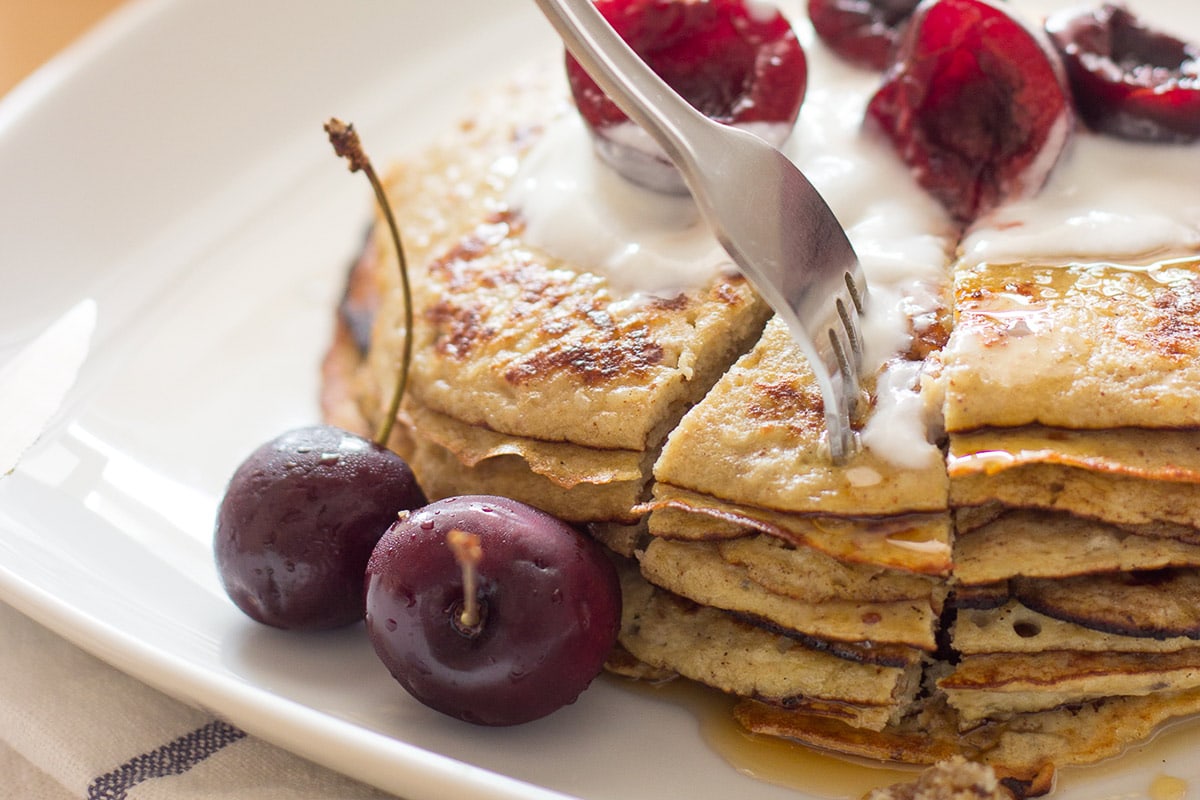
Green Vegetables and Leafy Greens
The more the merrier. We should try to get some greens on our plates every day, ideally twice.
From a protein perspective – you’ll have to eat loads! No way can I munch two bunches of broccoli a day for 18g of protein.
From a health perspective they’re seriously awesome though, and they should be included in almost any healthy vegetarian’s diet!
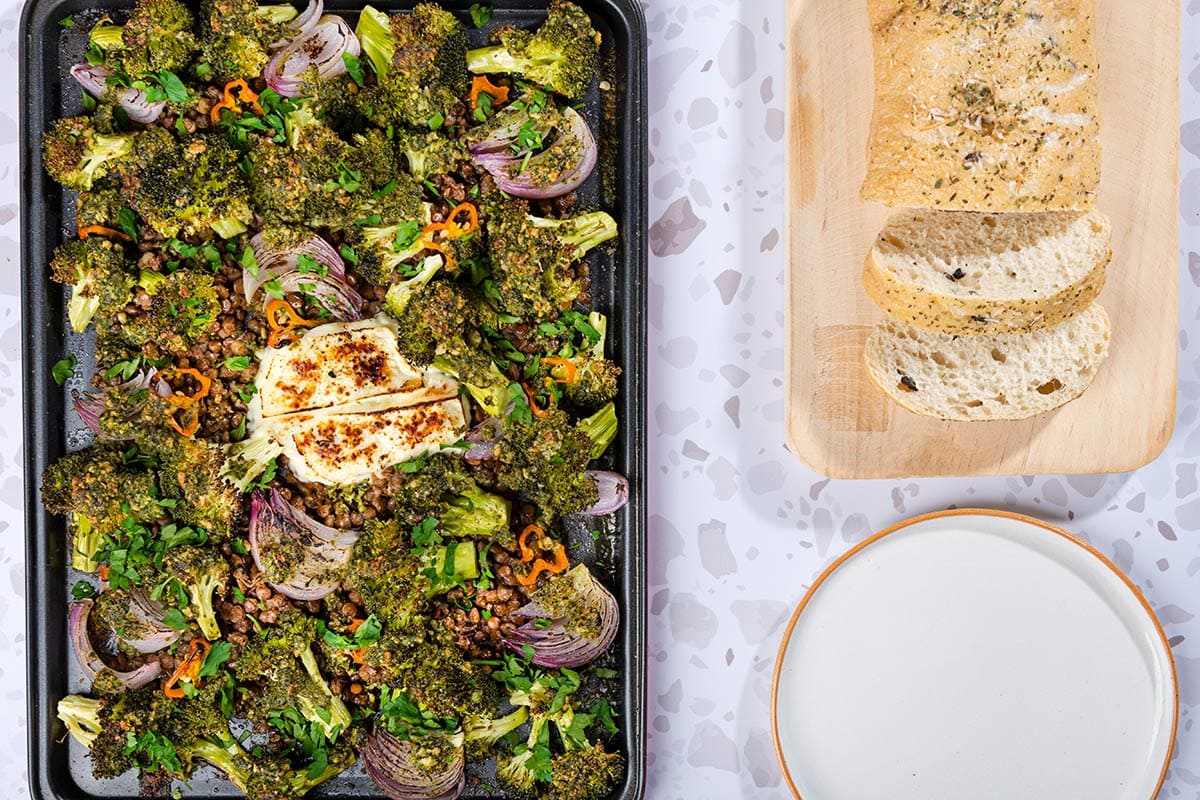
As vegetarians these are the best of the options we have when we’re looking for protein. As you can see many of the sources are best in moderation.
This is reason enough for me to put the first priority of our vegetarian high protein meal plan on balance.
If you focus first on adding as much protein as possible it is likely to result in an unbalanced diet, which might lead to health problems.
How much protein do we need?
The RDA, recommended daily allowance, is at a minimum of 0.36g of protein per pound of body weight (0.8g per kg bodyweight).
By percentage that would be roughly 10% of your daily caloric income. Note that is the minimum requirement for a non-active sedentary person to avoid a protein deficiency and get sick as a result. That means a full-on couch potato would just get by on that daily intake.
But how much protein does an active person need?
Of course this depends on your goals. But in general you can safely say if you want to build muscle you need more protein than that basic daily recommended allowance.
A higher protein intake is also likely to be beneficial for weight loss.
So, if you’re an active person, who does sports regularly, a healthy recommendation would be between 0.75g-1g of protein per lb of bodyweight per day (about 1.6-2.2 grams of protein per kg bodyweight).
By percentage that would be roughly 20-30% of your daily caloric income.
This is based on studies that have investigated the rates of something called muscle protein synthesis (essentially, new muscle being created) and how it differs depending on protein intake.
The more protein the better?
In the bodybuilding world often times 1g of protein per pound is recommended in order to make sure you don’t lose any “gainz”, but the validity of this rule has been doubted in the past.
The most recent research suggests anywhere between about 0.70g of protein per pound of body weight up to 1g of protein per pound seems to be the sweet spot for building muscle.
There are also concerns about the dangers of high protein diets in those with a long term health condition like chronic kidney disease – if you have any medical reason why you think a high protein diet might not be safe for you we would advise you to speak to your doctor.
Although there isn’t a definite consensus as to what the optimum amount of protein a day is for building muscle, we’ve made sure that the protein intake in our meal plan falls in line with the latest research.
And sure, you could have a bit more protein – but we’ve made sure there’s enough of it while still keeping the overall quality of the diet high.
Bottom Line
I have to admit that the question “You’re a vegetarian? But where do you get your protein, bro?” is not such a bad one after all – especially if you’re pursuing fitness goals.
But just filling up a meal plan with vegetarian high protein recipes and then just sending you off is not my style. This post has been prepared to give you as much information as possible for a vegetarian seeking a high protein diet.
For a vegetarian it is definitely possible to get in loads of protein in a healthy diet and this is what we’ve done with our healthy meal plan.
FAQs about this Vegetarian Meal Plan
We’ve answered some common questions we received about the meal plan, but if you can’t find an answer please let us know in the comments.
What if I don’t want to make one of the meals?
If you don’t like some of the recipes or just want to skip one, no problem! Make whatever else you like. You could also pick another meal on the plan and repeat it.
How many people is the plan designed for?
The meal plan is designed for one person and the nutrition and grocery list is based on this. You can easily adapt it though if you’re cooking for more than one though. Each meal in the plan links to the recipe on our website. The recipes include a handy tool that lets you enter how many servings you want to make and it will automatically update the ingredients needed – nifty huh? Just make sure to also update the grocery list in the plan where necessary.
Are there different versions of the meal plan?
Yes, there are three different versions, set to 1800kcal, 2200kcal and 2700kcal. You can also easily modify them by adding or removing snacks or meals.
Can I still drink alcohol whilst following the plan?
This is completely up to you, but for best results we recommend avoiding sugary soft drinks and alcohol, and sticking with water, tea and coffee instead. Although soft drinks and alcohol do contain calories, they are often known as ’empty calories’.
I recommend getting your calorie intake up to scratch with real foods – you’ll take in far more healthy vitamins and nutrients that way. My plan is to give a realistic meal plan that is both healthy and sustainable.
Of course, small amounts won’t ruin things, either. But remember your goals and you’ll hit them all the quicker 🔥
When should I start with the high protein vegetarian meal plan?
Begin whenever you like!
Can I use this for bodybuilding?
This report on bodybuilding and protein shows that bodybuilders should be aiming for a diet of about 0.63-0.77g protein per lb.
One of the three plans would likely be suitable to use as a vegetarian bodybuilding diet plan pdf, depending on bodyweight.
You should also tweak it to your exact requirements, and think about adding an extra protein shake to hit that 0.77g per pound if needed.
Depending on your weight that may take you even higher – up to the 1g per pound level.
Conversely, a heavier person may need a second shake to reach that level. Whey protein powder or a vegan protein powder would be just fine.
Which vegetarian food has the highest protein?
Pumpkin seeds, peanuts and cheese have the highest amount of protein per calorie.
Is this vegetarian diet plan healthy?
Yes. These plans are carefully constructed around our nutritional needs. We take great care to make sure you get plenty of protein, while also getting fatty acids, healthy fats, essential amino acids and lots of vitamins and nutrients.
Animal protein (through animal products like eggs and dairy) is included, as is plenty of plant protein.
We also keep the saturated fat down to guideline levels, and we generally stay away from meat substitutes as they are often very heavily processed.
The plans are also carefully checked by James, our Nutritionist. He is also in charge of staying on top of the latest research and guidelines, so you can be sure our plans are up to date, and indeed healthy.
Life after the meal plan
Your high protein diet journey probably won’t end after 7 days. We’re confident many of the recipes in our meal plan can become staples in your household, but we realise that you may want to shake things up and try new dishes once you have the basics down!
We’ve got hundreds of delicious and healthy recipes online already. Just use the search on our main page to find your next favourite, or click the link below to browse our high protein selection.
Need more? Try out our weekly vegetarian high protein meal plans!
You can also sign up for weekly high protein vegetarian meal plans to be sent right to your inbox every Thursday!
Find more high protein vegetarian recipes on our site
See you in the gym!
Disclosure
We would like to take a moment to note that this post is for information purposes only. It does not claim to provide medical advice or to be able to treat any medical condition. It makes no claims in respect to weight loss or building muscle, either in terms of the amount or rate at which said could be achieved. If you have any concerns regarding your health please contact your medical practitioner before making changes.


